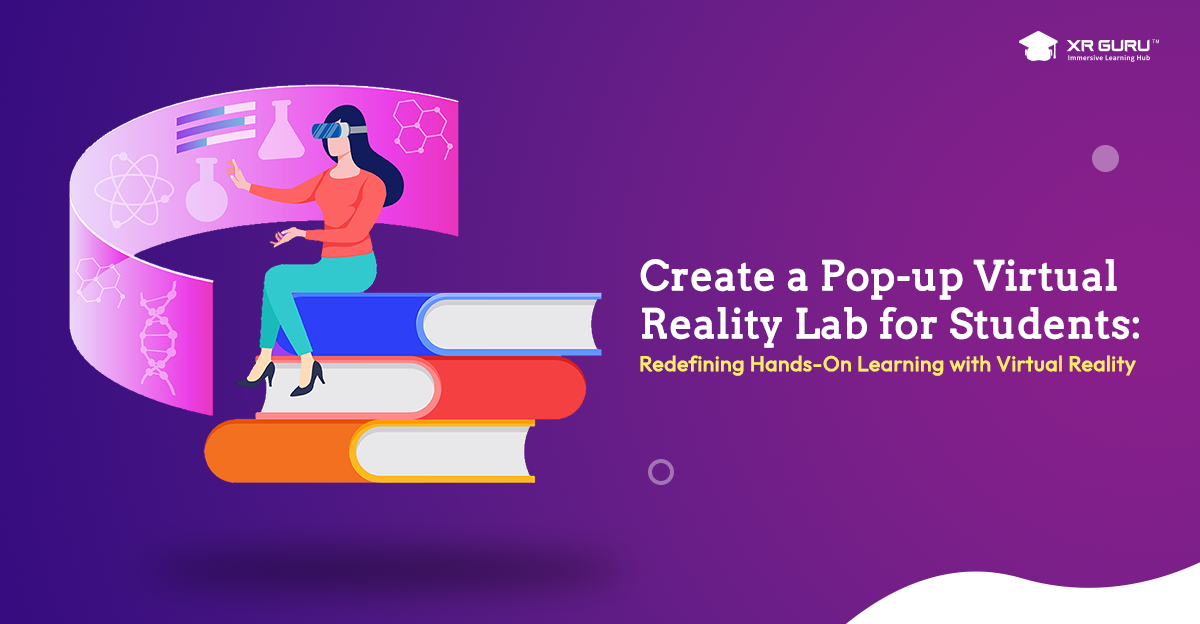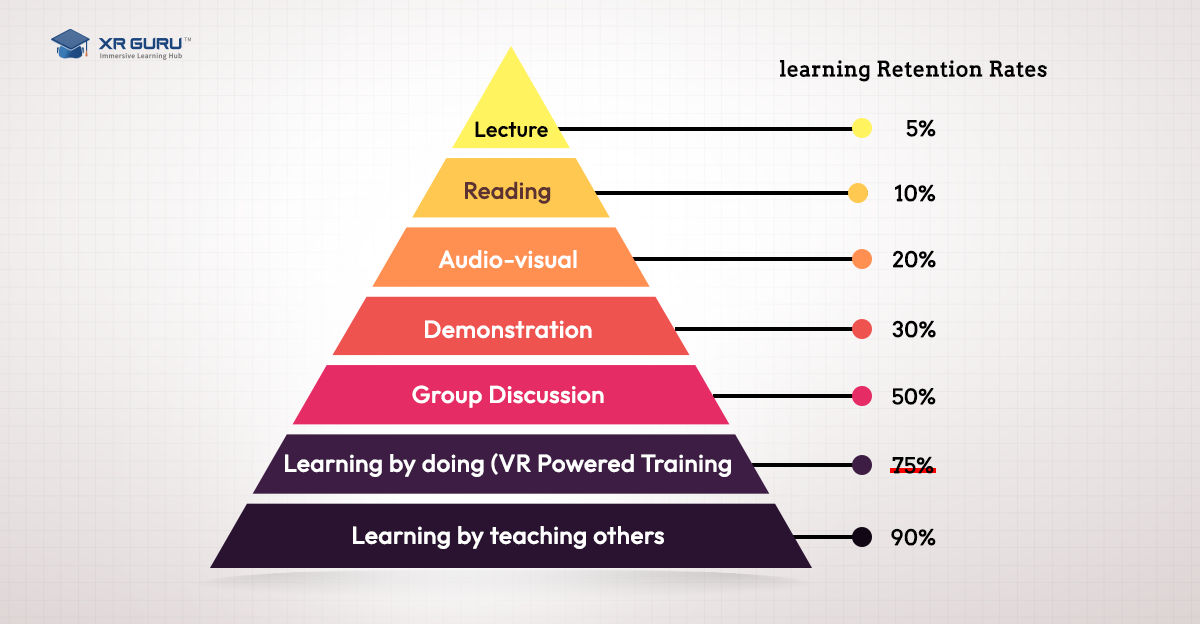
The digital transformation is also evading the education industry as more institutions are adopting online learning modes after the COVID-19 pandemic. While online learning has its advantages, there are a few disadvantages such as a lack of hands-on, practical elements. Even in traditional education, most schools do not have the budget to build state-of-the-art labs or buy advanced lab equipment.
Want to know how to overcome this challenge?
Incorporating Virtual Reality (VR) in education can bridge the gap between theory and practical learning. Virtual reality is making its mark in the EdTech realm, and educators around the globe are beginning to realize the immense benefits of using VR technology in learning. In fact, a study predicts the global AR/VR market in education is expected to reach $22.7 billion by 2027, growing at a compound annual growth rate (CAGR) of 14.6% during 2022-2027.
VR has the potential to revolutionize the way we teach and learn as it offers an experiential learning approach.
So, the question is, are you ready to implement VR in schools to redefine hands-on learning?
On February 17, 2022, XR Guru is conducting a webinar titled " Create a Pop-up Virtual Reality Lab for Students" to discuss how educators can use virtual reality to set up virtual reality labs to deliver immersive, practical education.
Join us to get insights on virtual reality labs!
Here is an overview of our blog:
- What is Virtual Reality?
- What is a Virtual Reality Lab?
- How is a Virtual Reality Lab Different from a Physical Lab?
- Things to Remember While Developing a VR Lab
- Equipment Required to Set Up a VR Laboratory
- Is VR Significantly Better Than Traditional Learning?
- What Benefits Does VR Labs Offer for Students & Institutions?
- Advantages of Virtual Reality Labs
What is Virtual Reality?
Before moving on to the finer details of VR labs, it is important to understand the basics of virtual reality.
Virtual reality technology creates computer-generated, interactive 3D simulations that captivate users. VR immerses users in a life-like environment and enables them to interact with engaging 3D graphical elements in the virtual world.
In simple terms, virtual reality is like a magic act that tricks you into believing you are somewhere you are physically not present.
What is a Virtual Reality Lab?
A virtual reality lab is an online scientific laboratory that people can access from remote locations. VR labs simulate computer-generated labs that mirror real-life physical laboratories.
VR labs offer a secure learning environment for students to perform laboratory experiments. VR labs provide access to advanced lab equipment that is not usually affordable or available to most for schools. Further, virtual labs greatly reduce the risk involved in a traditional lab setup and allow learners to perfect their skills without worrying about safety hazards.
How is a Virtual Reality Lab Different from a Physical Lab?
You may wonder, are VR labs better than conventional labs? What is the difference between virtual and physical labs?
Physical laboratories can be quite costly and take up a huge amount of space. Most schools have neither the budget nor space to construct best-in-class labs. Also, there are chances of accidents and physical injuries in physical laboratories. Using virtual reality to develop simulated labs greatly reduces the risk factor, plus they are very cost-effective.
Don't you think virtual reality labs are far more exciting and engaging than traditional labs? Join our webinar to learn how to create VR labs for a safe, immersive learning experience.
Things to Remember While Developing a VR Lab
Now that you have understood the fundamentals of virtual reality laboratories, you might ask the question, "How do I create a virtual reality lab for students?"
You need a virtual reality system to set up a VR lab; here are some things to keep in mind when developing a virtual lab.
- Financial Estimate: Deciding on a system that suits your budget is the first step. Analyze the potential expenses and effectiveness before choosing the ideal VR system.
- Personalization: A good VR system should be flexible enough to implement the latest technological advancements. Also, it should have the ability to accommodate your evolving educational needs.
- Compatibility: Finding a system that is compatible with a wide range of VR input and output devices is paramount in the process of creating a VR lab.
- Necessity: What do you want to accomplish with a virtual reality lab? Explore different use cases as some may require additional VR hardware equipment.
- Ease of Use: The system should be easy to use & comprehend, even for people who are not tech savvy.
- Quality User Experience: Selecting a VR platform that is highly responsive and capable of delivering high-quality visuals is crucial for a better user experience. A substandard system is going to be plagued with visual lags and slow responsiveness, which can cause motion sickness and loss of interest.
Equipment Required to Set Up a VR Laboratory
Once the software part is taken care of, the next question is, "What hardware is needed to develop a virtual reality lab?"
Here are some basic equipment you will need for a virtual laboratory setup.
- VR Headset: Several VR headsets are available in the market- Oculus Quest, Oculus Quest 2, Pico, and HTC Vive are some of the best virtual reality headsets available in the market. Choose a VR headset that satisfies your needs and aligns with your budget.
- Input Devices: Hand controllers, Keyboard, Mouse, etc.
- Accessories: VR gloves, Motion trackers, Optical trackers
- Audio Devices: Speakers, Headphones.
Is VR Significantly Better Than Traditional Learning?
Are you still not convinced virtual reality in schools is a good thing?
It is natural to have such queries before investing large sums in a project. But worry not, we have stats to back our claim that virtual reality will help transform the educational process.
According to the National Training Labs, USA, the knowledge retention rates for traditional methods such as lecture and reading-based learning are 5% and 10% respectively, whereas the retention rate is 75% for VR-based education.
 |
(Source: National Training Laboratories, USA) |
A study conducted by PwC shows virtual reality learning enables students to learn new information 4 times faster than students in a traditional classroom setup.
 |
| (Source) |
A recent study by the World Bank Group reveals the extent to which VR can successfully develop students' skills. Some key findings of the study are as follows:
- Students in VR-based training report 20% higher levels of confidence and self-efficacy towards learning.
- Students exposed to VR training are up to 30% more efficient compared to learners in a traditional environment.
Advantages of Virtual Reality Labs
How can students and institutions benefit from VR labs?
There are several benefits to adopting virtual reality in classrooms to deliver hands-on learning, below are a few of them.
Access to Cutting-edge Equipment
Most schools operate on a shoestring budget, so they cannot afford highly advanced lab equipment.
Worried you are compromising the learning experience with sub-par lab equipment?
You do not have to settle for outdated or low-grade equipment; VR is here to lend a helping hand, as virtual labs provide easy access to ultramodern equipment and help students learn advanced topics.
Low-Risk Training Environment
In a conventional laboratory setup, there is the ever-present fear of physical injuries or damage to property. However, a virtual lab greatly reduces the risks involved in traditional labs and offers a secure environment for students to perfect their skills. With VR, students can commit mistakes and learn from them without worrying about the consequences.
For instance, medical students can learn to operate and perform surgeries without causing harm to a real-life patient.
Cost-Effective
Often people perceive VR as an expensive technology with limited value. However, that is not the case. While the initial hardware can be expenses, the benefits certainly justify the upfront costs. In fact, VR proves to be extremely cost-effective as it eliminates the cost of constructing labs and acquiring/maintaining lab apparatus.
Heightened Engagement & Collaboration
With visually stunning virtual reality experiences, students are more engaged in classroom activities and are seldom distracted. The highly immersive nature of VR stimulates students' curiosity, allowing them to test out complex experiments in a virtual setup. In addition, features like VR avatars and virtual meetups enhance student-teacher collaboration.
Are you excited by the potential of VR in schools? Join our webinar session to learn more about creating virtual reality labs.
Rejuvenate Hands-on Learning with Virtual Reality
Adopting virtual reality in education results in a better practical learning experience and is more effective, fun, and engaging than conventional learning/teaching methods. VR labs have an array of advantages, and the above-stated are just scratching the surface of this fascinating technology. VR hardware is becoming more affordable and adopting VR in your school will make education hands-on, immersive, and interactive.
So, are you ready to be a part of the VR educational revolution?
Want to incorporate VR for a better learning experience? XR Guru is a next-gen educational application that brings learning, content creation, and distribution under one roof. Using XR Guru helps make teaching complex concepts easier with immersive content. Choose XR Guru to advance learning and training in the metaverse! Contact us for a free consultation.
Join Us for Our Next Webinar
Title: Create a Pop-up Virtual Reality Lab for Students
Gear Up for Experiential Learning
Educators around the globe are beginning to realize the potential of using VR in schools to make learning hands-on and immersive. In fact, many schools are purchasing 3-10 virtual reality (VR) headsets to begin exploring the various VR content experiences in the classroom.
Join our live webinar on February 17, 2022, to learn more about integrating immersive technology into your school.
If you cannot attend, register anyway, we will send you the recording.
Host: Doug Smith
When and Where:
11:30 a.m. EST, Tuesday, February 17, 2022
25 Minutes
Zoom Link (sent after registration)
Goal: To help educators create virtual reality labs in schools and illustrate the benefits of adopting a VR-based learning approach.
Who Should Join:
- Principals (HS and MS)
- Content Creators
- Subject Matter Experts
- Physics, Chemistry, and Biology Educators
- Administrators, and
- Those willing to incorporate VR in education.
Highlights of the Webinar:
- Learn the research on VR/AR learning in education
- Learn how to start a pop-up VR lab
- View samples of the content
- Learn about accessing the School Admin/Teacher Portal
- Register for free full access to experience all modules.
Outcome: Attending this webinar can help you learn how to create VR labs for a practical learning experience.